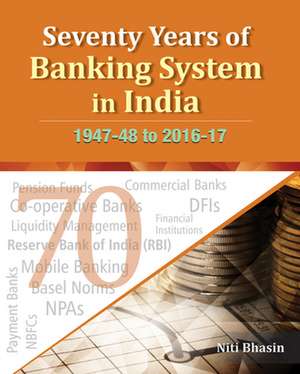Seventy Years of Banking System in India: 1947-48 to 2016-17
Autor Dr Niti Bhasinen Limba Engleză Hardback – 12 aug 2016
Preț: 693.00 lei
Preț vechi: 780.12 lei
-11% Nou
Puncte Express: 1040
Preț estimativ în valută:
132.62€ • 137.67$ • 110.58£
132.62€ • 137.67$ • 110.58£
Carte indisponibilă temporar
Doresc să fiu notificat când acest titlu va fi disponibil:
Se trimite...
Preluare comenzi: 021 569.72.76
Specificații
ISBN-13: 9788177084337
ISBN-10: 817708433X
Pagini: 370
Dimensiuni: 190 x 250 x 34 mm
Greutate: 1.07 kg
Editura: New Century Publications
Colecția New Century Publications (IND)
ISBN-10: 817708433X
Pagini: 370
Dimensiuni: 190 x 250 x 34 mm
Greutate: 1.07 kg
Editura: New Century Publications
Colecția New Century Publications (IND)
Cuprins
Indian Financial System: An Overview; Classification, Regulation & Supervision of Financial Institutions in India; Reserve Bank of India: History & Functions; Reserve Bank of India: Monetary Policy & Liquidity Management; Reserve Bank of India: Post-Independence Review of Role & Responsibilities; Commercial Banks: Pre-Independence History; Commercial Banks: Post-Independence History & Developments; Commercial Banks: Legal Framework, Ownership & Governance; Commercial Banks: Credit Allocation Policies; Commercial Banks: Prudential Regulatory Framework & Supervision; Commercial Banks: Migration to Basel Norms; Commercial Banks: Management of Non-performing Assets (NPAs); Commercial Banks: Customer Care & Services; Regional Rural Banks (RRBs); Payment Banks; Foreign Banks in India; Urban Co-operative Banks (UCBs); Rural Co-operative Credit Institutions; Development Finance Institutions (DFIs); Non-banking Financial Companies (NBFCs); Mutual Funds; Pension Funds; Insurance Organisations; Internet Banking; Mobile Banking; Digitization of Financial Services; Bibliography; Index.
